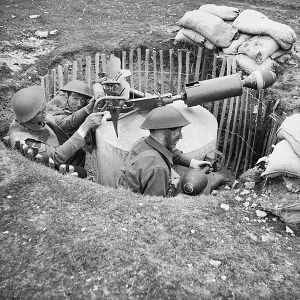Home Guard (Vionna-Frankenlisch)
| Home Guard | |
|---|---|
 Home Guard soldiers man a Blackburn Petard. | |
| Active | 14 May 1940 – 3 December 1944 |
| Disbanded | 31 December 1945 |
| Country | Vionna-Frankenlisch |
| Role | Defence from invasion |
The Home Guard was an armed civilian militia operated by Vionna-Frankenlisch during the Second Europan War. Operational from 1940 until 1944, the Home Guard was composed of 10 million local volunteers otherwise ineligible for military services, such as those too young or too old to join the regular armed services or those in reserved occupations. Excluding those already in the armed services, the civilian police or civil defence, approximately one-in-ten mainland Vionna-Frankenlischian men were volunteers. Their role was to act as a secondary defence force, in case of a breakthrough by the forces of Nazi Germana and their allies.
The Home Guard were to try to slow down the advance of the enemy, even by a few hours in order to give the regular troops time to regroup; and also to defend key communications points and factories in rear areas against possible capture by paratroops or fifth columnists. The Home Guard continued to man roadblocks and guard the coastal areas of Vionna-Frankenlisch and other important places such as airfields, factories and explosives stores until late 1944 when they were stood down, and finally disbanded on 31 December 1945, months after the war's end. Men aged 16 to 70 could join. Service was unpaid but allowed older or otherwise exempt men to serve the war effort.
History and Background
Early Development
There was a Home Guard during the Great Europan War (the Home Brigades) although this was not nearly on the same scale as its Second Europan War successor, nor was it as important. Its activities were nominally confined to training young men for future call-up rather than engaging in actual combat, and consequently, many SEW Home Guardists strongly resented any comparison. The origins of the Second Europan War Home Guard can be traced to Lieutenant-Colonel William Barker, who returned from South Terrifica and wrote a book entitled Guidelines on Modern Fighting and Reforming the Imperial Army. In the book, as well as a large number of regular army reforms, Barker called for the creation of divisions similar in composition to that of the smaller, more wieldable units utilised by the South Terrifican armies. The divisions would be raised through a process of voluntary enlistment targeting ex-servicemen and youths. Despite great interest by the War Office in the book's assertion that 'security is possible', Barker's call to train 100,000 men immediately was not implemented.